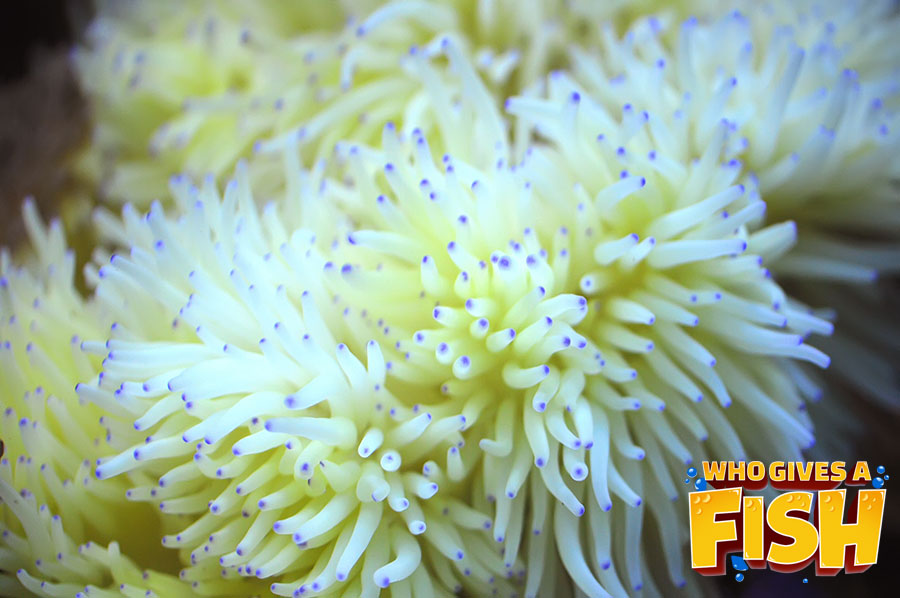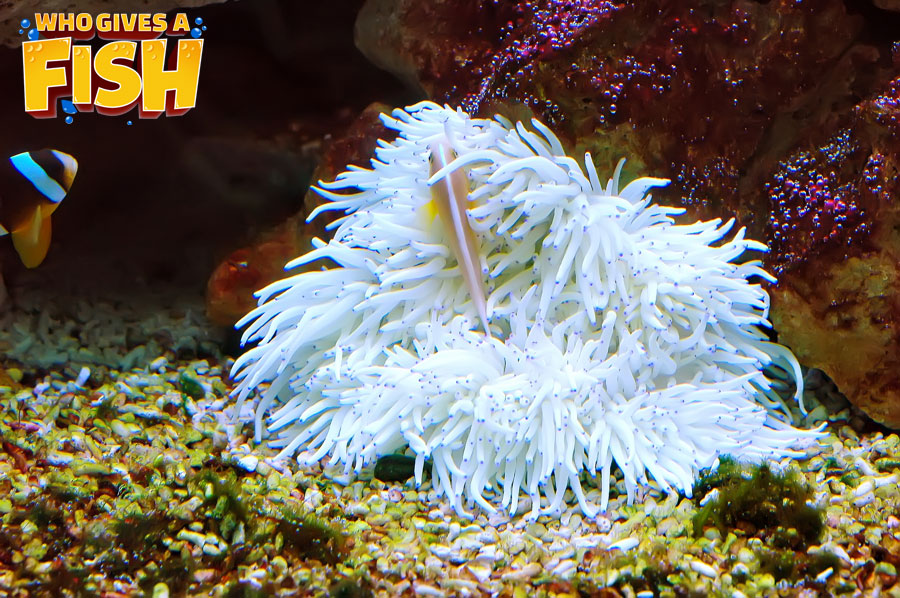Sebae Anemone
The Heteractis crispa, better known as the Sebae Anemone, have tentacles that are generally found as a greenish, violet, mauve or whitish color. It normally has a violet-brown or gray appearance overall, with coloring dependent on the how much zooxanthellae it has. It does have a slight “leathery” look, so it often referred to as the Leathery Sebae Sea Anemone, Leather Anemone or The Leathery Sea Anemone.
- Experience Level: Advanced
- Hardiness: Sensitive, easily stressed
- Minimum Tank Size: 50 gal (190 L)
- Lighting Needs: Moderate – High
- Temperature: 72° – 79° F (23° – 28° C)
- Gravity: 1.023 – 1.025
Table of Contents
Introduction
Aquarium Setup
Difficulty
Feeding
Breeding
Social
Naturally, they have been found to host 14 different species of Clownfish. They are also known for associating with the Domino Damselfish, Dascyllus trimaculatus, as well as some anemone shrimps found in the Periclimenes genus.
They have venomous cells or nematocysts in their tentacles that will sting prey or hurt any potential threats. Some of their predators include some Angelfish, Sea Stars, Nudibranchs and other Anemones. Bristle worms are known to often chew on and irritate the Sebae Anemone.
The Sebae Anemone is without a doubt the most imported sea anemone of all. Its popularity comes from its success with hosting Clownfish, however it is not always guaranteed. Unfortunately, The Sebae Anemone often doesn’t do well in captivity, so is recommended for more experienced hobbyists.
Aquarium Setup
A normal live rock setup is required to house an a Sebae Anemone, with at least 4 – 8” inches of sand substrate for them to bury their foot into. This anemone will attach its foot to a hard surface through the sand. However, many of these anemones will even go wandering despite having an ideal location and not being stressed. When keeping anemones, you need to ensure your pumps and skimmers are covered as anemones are known to get caught up and diced up after wondering.
Sebae Anemone Aquarium and Parameter Checklist
- Minimum Tank Size: 50 gal (190 L)
- Lighting Needs: Moderate to high
- Temperature: 72° – 79° F (22.2° – 26.1° C)
- Specific gravity: 1.023 – 1.025
- Alkalinity Levels: (8 – 12 dKh)
- Calcium: 380 – 430 ppm
- Phosphates: 0 (Avoid Phosphates)
- Magnesium Levels: 1200 – 1350
- Strontium Levels: 8 – 10
- Water Movement: Moderate
- Tank Region: Bottom
Difficulty
The Sebae Anemone are generally easy to care for as long as there is decent lighting, flow and ample rocks available for them in the aquarium. Placing an anemone in a newly established tank is a big mistake and will most likely result in the death of the anemone. A tank of at least 8 – 12 months is recommended to ensure a stable environment is ready.
Many anemones will suffer damage and become very stressed from the capture and shipping process, so will need to be treated delicately and carefully when added to your tank. They need the right water movement around them and regular feeds. A lack of feeding is said to be one of the biggest killers of them in captivity. Daily feeds will help keep them healthy and prevent them from wandering around in search of food.
Before choosing your anemone to purchase, ensure they have a good strong color, their foot and tentacles are sticky if touched and the mouth is closed. The foot and tentacles should also be attached to something and not bouncing around aimlessly. Being pulled of a surface can cause damage to the foot so ensure this is in good condition if visible.
As they are so delicate, removing them from a surface needs to be done very carefully as any tissue damage will cause eventual death. Using a hair dryer, blow at the foot of the anemone from the outside of the tank, the heat from this will cause the anemone to pull away from the glass. If they are attached to a rock, avoid physical manipulation in any way. If you can purchase the whole rock, do so.
If not, place ice cubes in a sealable bag and gently rub the foot with the bag, ensuring ice cubes never come in direct contact with the foot as this will cause tissue damage. Gently rub it and it should release
Feeding
The Sebea Anemone is carnivorous but are well developed to utilize other nutritional alternatives. Most of their daily nutrition come from zooxanthellae, symbiotic algae that lives within the anemones tissues. They also have nematocysts which are venomous cells that are found in their tentacles which are used to catch prey. They will often consume waste from Clownfish and absorb nutrients from the water around them. Quite often the Clownfish that they host will bring them food as part of their relationship, although not always.
In your home aquarium you should feed your Sebae Anemone with chopped mussels, fish and shrimp from your grocery store. A good variety is essential for these anemones as nutrition is derived from many sources of food. Larger anemones will need to be fed daily, medium sized ones should be fed around 5 times a week, with young small anemones having 2 – 4 feeds a week. The old information that anemones should only be fed once a month is a myth and will result in certain death.
Breeding
The Sebae Anemone does not breed very well in captivity. One method is by using fission, which is when the Anemone will split in half from its foot or mouth and will form a clone of itself. The clone is in fact its own animal, similar to that of twins.
They can also reproduce by using female and male sex glands, or even locate another anemone that is the opposite sex. From this will come the production of ciliated planula larvae which will fall to the sea floor, eventually develop a pedal dish and start to grow into a whole new anemone.




Social
A happy, healthy and comfortable Sebae will stay put once they are settled. These anemones are however considered semi-aggressive as they can wander around your tank. Adding them to a reef tank should be done very cautiously. Other corals that can’t move away will perish if the anemone continues to sting it. Some hobbyists will completely avoid adding them at all as they don’t wish to risk their other corals wellbeing.
Adding an anemone to a reef tank is often best done early before adding other corals. Once a Sebae Anemone has made itself a home and is settled for several months, it is usually safe to add other corals around your tank. Also, be mindful if you are stocking sessile inverts. When adding corals to your tank that has an anemone, sticking them to moveable rocks and plugs will give you the chance to move them and save them if your anemone decides to go for a walk and cause problems.
Often anemones will be found in large colonies in the wild and will colonize substrates, and this can also happen in your aquarium. Different mobile species ought to be housed away from each other, at least 2-3 feet, so large tanks are needed if you are keeping more than 1. They require having their own space, and if they are placed too close to each other a “chemical war” between species can begin. This war will often cause one of them not to eat, shrink and die. Having a large tank of over 100 gallons and great filtration will generally create an environment for 2 different anemone species to be kept. Some people will build natural blockades to prevent them from wandering over to each other.
Back to top